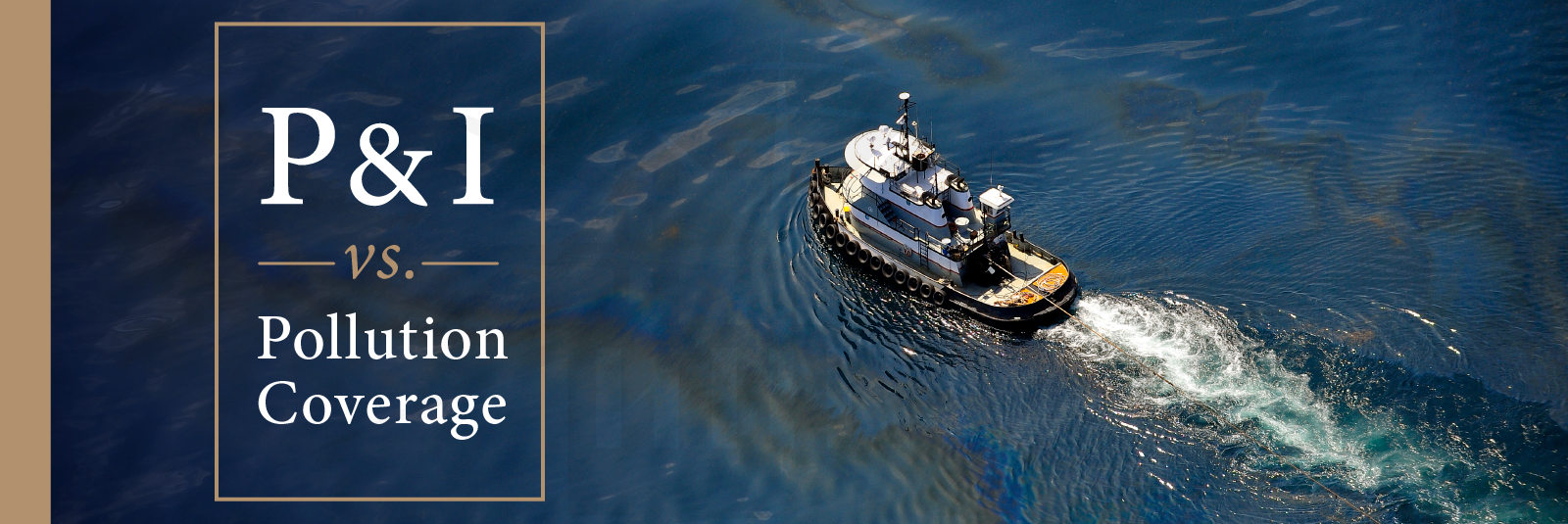When it comes to marine insurance policies, you might already know a little about P&I coverage and vessel pollution coverage. You may have even heard of the P&I pollution Buy-Back endorsement. But what exactly are the differences between these policies and why are they important?
To help you make sense of some of the available insurance options, we’ll walk through a basic overview of these two types of vessel insurance coverages.
Protection & Indemnity Coverage
Protection and Indemnity (P&I) insurance provides broad coverage to commercial ship operators, owners, and charterers for practically all maritime liability risks associated with owning and operating a vessel. This policy covers everything from damages to property and crew medical expenses to oil spills and loss of life in certain situations.
There is no standard form when it comes to P&I. Instead, these insurance policies are flexible — underwriters tailor each one with specific terms and conditions that take into consideration the nature of the risk with details such as:
- Type of business and purpose of the vessel
- Type and condition of the vessel
- Number of humans on board (crew, passengers, etc.)
- Type of cargo
- Navigation limits
- Claims history
- Amount of coverage requested by the insured
P&I offers wide-reaching coverage, going beyond what hull and cargo coverage traditionally offer. This expansive policy addresses third-party lawsuits that could stem from the crew, passengers, other vessels, or properties.
A typical P&I policy covers:
- Loss of life, injury, and illness of crew, passengers, and third parties (excluding liabilities under statutory compensation acts such as workers' compensation)
- Damage, loss, or shortage of cargo on board the vessel
- Damage to piers, docks, jetties, and other fixed floating objects
- Damage to other vessels
- Quarantine costs
- Wreck removal costs
- Pollution
- Fines and penalties
- War risks and politically motivated actions
- Stowaways and repatriation
Because vessels face so many unique challenges and risks, it’s important to have financial protection from a wide range of lawsuits and claims. With that said, this policy doesn’t cover everything, as there are exceptions. Also, keep in mind, with P&I policies, insurers are not obligated to pay claims unless the insured is found at fault and on the hook financially.
Vessel Pollution Coverage
Vessel pollution coverage is another important insurance policy, but when compared to P&I, it is much more narrowly focused. As its name suggests, this insurance solely addresses pollution. It provides comprehensive coverage for both the vessel owner and operator in the event or threat of spills.
It doesn’t matter whether the oil spill was intentional or not--the effects of this kind of pollution can be devastating and far-reaching. Not only can a spill damage the ecosystem, killing plants and animals, but it can pollute the water, disrupt the local fishing industry, destroy crops, and much more. And of course, all of this disruption comes with a hefty price tag.
If a spill occurs, shipowners and operators are exposed to a number of potential liabilities, such as:
- Clean Up
- Damages to the environment and natural resources
- Damages to property
- Loss of revenue and profit by third parties
- Civil penalties
- Criminal fines
- Legal Fees
A comprehensive marine pollution insurance policy is the best way for owners and operators to protect themselves from the damage (both literal and financial) spills can cause. However, as we noticed with P&I, this insurance coverage has its limitations and does not cover every possible liability associated with pollution.
P&I Pollution Buy-Back Endorsement
Although the above coverages are different, they are often tied together in the event of an incident. But where does the P&I pollution Buy-Back endorsement come into play?
Basically, this endorsement was created as an extension to the two previously mentioned insurance policies to cover gaps. Contrary to popular belief, the P&I pollution Buy-Back endorsement does not cover the same exposures as the vessel liability pollution form. But rather, it was created to complement the vessel liability pollution form.
In 1976, The American Institute developed a solution to provide coordinated coverage with a newly created vessel pollution liability policy form: The American Institute Pollution Exclusion Clause and the pollution Buy-Back endorsement. The Buy-Back provides coverage for some exposures that were excluded in both the P&I and the vessel pollution policy form.
What does the Buy-Back actually cover? It covers bodily injury arising from a pollution event, along with loss or damage to cargoes (whether on an insured vessel, on another vessel, ashore, or due to contamination from pumping).
In comparison, the vessel pollution only provides coverage for spills and threats of spills from vessels in regards to clean up and removal costs, third-party property damage, assessment of and damage to natural resources, loss of revenues and profits by third parties, loss of public services, investigation and defense, advertising, civil and criminal fines/penalties, cleaning of decks and surfaces, property damage ashore, international conventions, and state law liabilities.
The same goes for P&I. While P&I insurance does cover liabilities involving oil pollution, it, too, fails to address injuries or cargo damages associated with the spill.
This simplistic comparison of P&I and vessel pollution coverage illustrates how vastly different they are, but also how they can work together to form a more comprehensive protection for the vessel owner in the case of a pollution event.
The Final Takeaway
Vessel pollution insurance is very niche and focused on one specific type of risk, whereas P&I insurance covers a broader scope of liability. Vessel owners and operators need the additional protection of pollution insurance to ensure they are as protected from as much risk as possible.
Learn more about pollution insurance with Safe Harbor. Our personalized approach and innovative spirit means that we can be more agile than any other carrier in the vessel pollution space, and offer the broadest coverage form in the industry—all at a competitive price.





